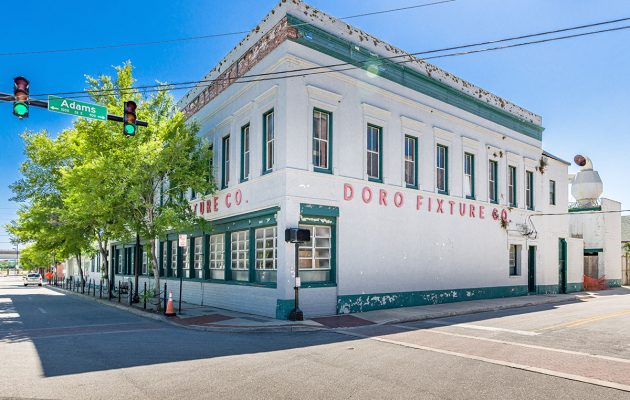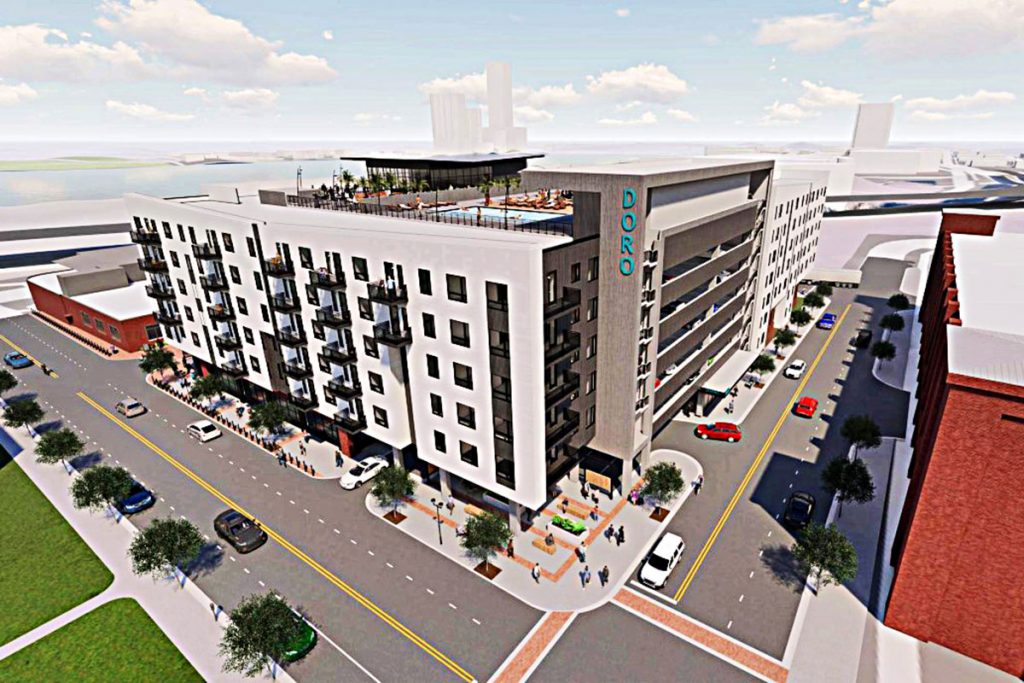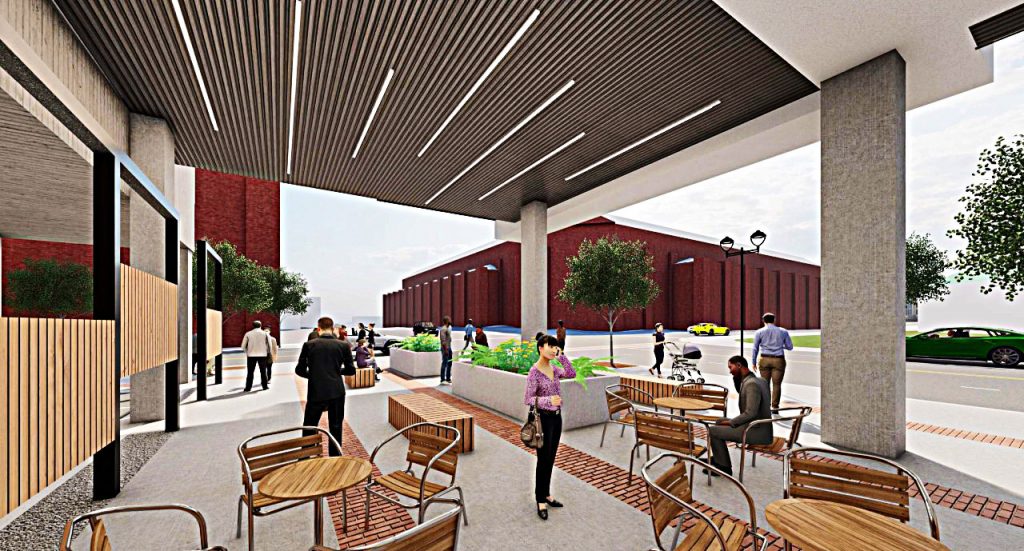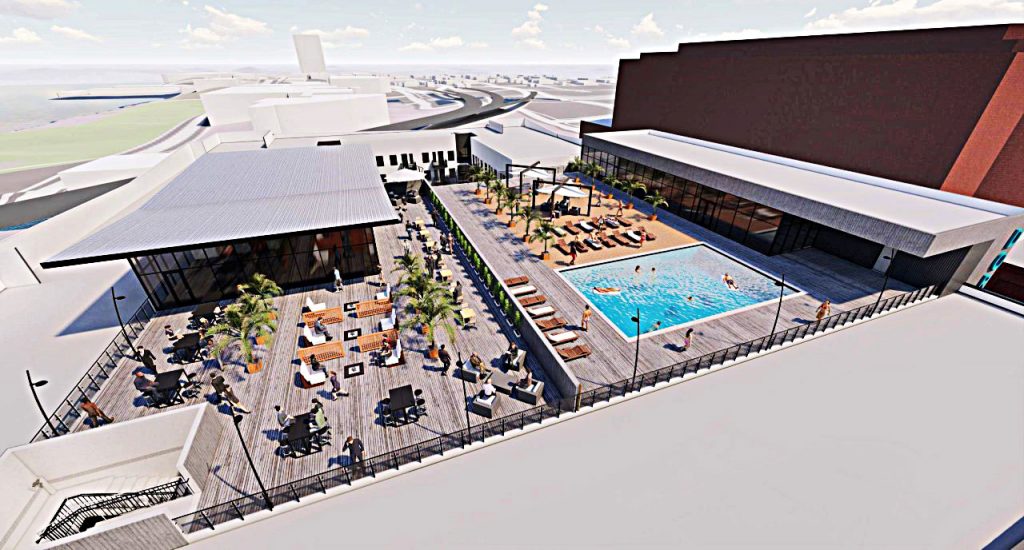Historic Doro building to be replaced by modern apartments, retail
Posted on July 6, 2020 By Editor Brooklyn, Downtown, Springfield, Neighborhood News, Top Stories

Plans to demolish a historic 115-year-old building near Jacksonville’s shipyards and erect apartments in its place are moving forward even though some civic organizations and community members have called for a halt to progress on the project.
The George Doro Fixture Company building – with its unusually formal façade and ornately outlined windows and sign displaying vintage script – has itself been a fixture at 128 A. Philip Randolph Blvd. since a handful of years after Jacksonville’s Great Fire of 1901. Occupied by its namesake founder’s cabinet-making business and ensuing generations of his family since 1925, the building has been vacant several years, since the business closed in 2016, local historians say.

Now, Augusta-based Rise LLC is moving forward with plans to demolish the buildings and construct a brand-new, eight-story mixed use development project that will house 247 units and include an urban open space plaza, a roof deck with multiple amenities, ground floor retail and interior parking. Builders also plan to include about 6,100 square feet of plaza to serve as an urban open space at the corner of A. Philip Randolph and East Adams Street, city document show. That space is to be filled with streetlights, benches, and still-to-be-determined interactive features such as public art displays, sculptures or water features.
When complete, the eight-story development will be called the Doro.
The Downtown Development Review Board approved demolition of the George Doro Fixture Company on A. Phillip Randolph Boulevard and rubber stamped plans for the final version of the project in May, and now it must go through the City’s Development Services Division before proceeding.
The project, located in the stadium district, spans an entire block bounded to the north and south by East Adams and Forsyth Streets and to the east and west by A. Phillip Randolph Boulevard and Lafayette Street.

Because the structures occupying the site are not protected by a historic designation, the DDRB gave the final OK to tear them down. And though many in the community hoped some features of the old building would be incorporated, City staff said that ultimately, it was up to the developer, who chose not to do so.
“Staff gets and very much appreciates why people have strong sentiments toward preserving the building, and we understand it. We’re also very appreciative of those who have taken the time out of their lives to write staff, to write to the Council, to write people and express their caring for downtown and this project, and those who took the time out to attend this meeting. It is not lost on us,” Downtown Investment Authority Operations Manager Guy Parola said during the meeting, which was conducted on Zoom and attended by many who spoke out against the project.
City staff had encouraged the developer to preserve street facing facades from the building and incorporate them into the design “but at the end of the day, absent historic designation protections neither (DDRB) board or staff can compel the property owner to preserve the building in part or parcel,” Parola said.
Nick Hill of Niles Bolton Associations in Atlanta, the design firm for the project, highlighted some features the new project would offer, including creating retail growth and community engagement along a nearby section of Forsyth Streets, which he described as abandoned.

“We are looking to turn that into an active urban zone that addresses the retail here,” he said, adding there would be a dog wash off East Forsyth and bike storage added. The eighth floor of the complex is to feature multiple amenities including a retail terrace and bar area that will be connected down to the retail space at street level.
Hill said project managers are looking over options for public art to choose “what is the most appropriate and what connects to Jacksonville the best in this area.” The complex is also to be surrounded by landscaping that will shade pedestrians walking in the area.
Nancy Powell, executive director of Scenic Jacksonville, spoke for many when she said, “This is a very sad day for many people who understand that the building is historic. It is not landmark, yet it is historic.”
In June, Wayne Wood, Jacksonville Historical Society historian-at-large and preservationist, also echoed the sentiment. “Is this the most significant historical building in Jacksonville? No, it is not the crown jewel. At the same time, it is representative of the neighborhood and is one of the last ones that’s there. It is very strong from an architectural standpoint. It should be saved. We have lost so many of our historical buildings.”
George Doro and the east side
Depending on which historian you talk to, the most important aspect of the property could be the building itself or the family it represents. The answer is probably both.
George Doro was not the first occupant of the building; that would be a Max Salzmann, according to the City Directory of that time, and a succession of different occupants would live in the building until Doro moved in around 1925, bringing his name, a thriving business, and his own sorrows with him.
Jacksonville Historical Society Senior Archivist Mitch Hemann said Doro, a Rhode Island native, was a veteran who survived World War 1 as the only one of five brothers to return to his parents from the war. A skilled woodworker, he resettled in Mandarin and began his company in 1919. His wife, Gertrude, was a professional songwriter who published music that was recorded by various artists.
When Doro took over the building, the business was surrounded by a lively, vibrant African American neighborhood where many made a living building or servicing ships. There was a billiards hall on Florida Avenue and an entertainment venue called the Savoy nearby.
“There was a lot going on there,” Hemann said. “The Savoy was known to be a meeting spot for people in the neighborhood to get picked up and find shipping work along the river. It was a very different time.” As Doro built his business, he became a significant employer in the neighborhood.
Eventually, his son William took over the business and then his grandson William Doro Jr., but the business closed for unclear reasons four years ago after remaining more than eight decades in the family.
“There were a couple of major events that contributed to the decline of the Florida Avenue business district,” Wood said. “The first would be Hurricane Dora in 1964, which did considerable damage to the businesses in that area.
“The second would be the Eastside Riot of 1969, when a white cigarette salesman believed a young black man named Buck Riley was burglarizing his truck and shot at him. He continued firing his gun into a group of school children as Riley fled. The neighborhood retaliated and the salesman found himself outnumbered. His truck was overturned and a riot quickly ensued. Fires were started, and bricks and rocks were thrown through windows of local businesses. The district has made many attempts to revitalize, but struggles even today,” Wood continued.
“Part of the reason we hoped it would not be torn down is because A. Philip Randolph still has a few of its historic facades, especially Old St. Andrews Church, which dates back to the 1880s and the Merrill House, from even before the 1880s,” he said, noting that both properties now belong to the historical society. “In that three block area there are buildings that still have a flavor of what was there.”
By Jennifer Edwards
Resident Community News




 (No Ratings Yet)
(No Ratings Yet)




